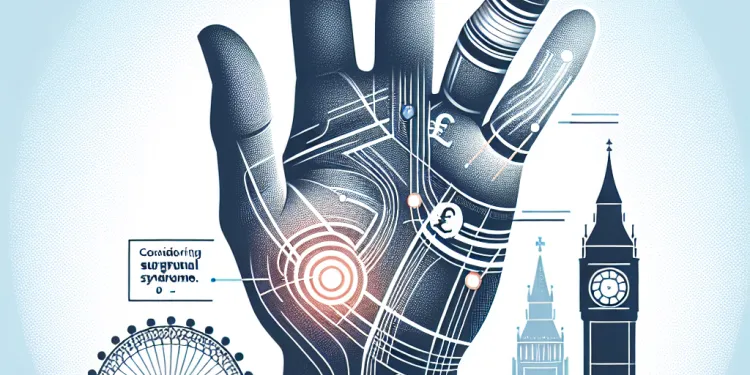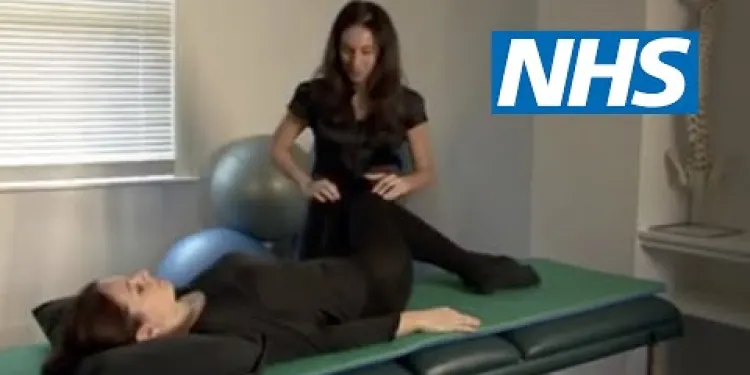Find Help
More Items From Ergsy search
-

Carpal Tunnel Syndrome
Relevance: 100%
-

What causes Carpal Tunnel Syndrome?
Relevance: 95%
-

Is Carpal Tunnel Syndrome covered by the NHS?
Relevance: 94%
-

How is Carpal Tunnel Syndrome diagnosed?
Relevance: 93%
-

What is Carpal Tunnel Syndrome (CTS)?
Relevance: 92%
-

How can I prevent Carpal Tunnel Syndrome?
Relevance: 90%
-

Are there any alternative treatments for Carpal Tunnel Syndrome?
Relevance: 87%
-

Can Carpal Tunnel Syndrome recur after treatment?
Relevance: 86%
-

When should I consider surgery for Carpal Tunnel Syndrome?
Relevance: 86%
-

Are there specific exercises that can help with Carpal Tunnel Syndrome?
Relevance: 86%
-

What does Carpal Tunnel Syndrome surgery involve?
Relevance: 85%
-

What non-surgical treatments are available for Carpal Tunnel Syndrome?
Relevance: 84%
-

What are the common symptoms of Carpal Tunnel Syndrome?
Relevance: 79%
-

Can I work or continue sports activities if I have Carpal Tunnel Syndrome?
Relevance: 77%
-

Can lifestyle changes help manage Carpal Tunnel Syndrome?
Relevance: 77%
-

What is the recovery time after Carpal Tunnel Surgery?
Relevance: 64%
-

What is Cushing's syndrome?
Relevance: 26%
-

Munchausen's syndrome | NHS
Relevance: 26%
-

Prader-Willi Syndrome | NHS
Relevance: 25%
-

Is chronic fatigue syndrome contagious?
Relevance: 24%
-

Turner syndrome: Beyond the classic XO phenotype
Relevance: 24%
-

Having a child with Down's syndrome | NHS
Relevance: 24%
-

Down's syndrome: Emily's story | NHS
Relevance: 24%
-

Charles Bonnet Syndrome
Relevance: 24%
-

What causes chronic fatigue syndrome?
Relevance: 23%
-

Exercises for sciatica: piriformis syndrome | NHS
Relevance: 23%
-

What is complex sleep apnea syndrome?
Relevance: 23%
-

What is complex sleep apnea syndrome?
Relevance: 23%
-

What is chronic fatigue syndrome?
Relevance: 23%
-

What is congenital rubella syndrome?
Relevance: 22%
-

Having a child with Edwards' syndrome (trisomy 18) | NHS
Relevance: 22%
-

What is the difference between autism and Asperger's syndrome?
Relevance: 22%
-

Are there psychological aspects to chronic fatigue syndrome?
Relevance: 21%
-

Is chronic fatigue syndrome a mental illness?
Relevance: 21%
-

Greater trochanteric pain syndrome
Relevance: 21%
-

Building Understanding and Supporting Your Child with Tourette’s Syndrome/Tics
Relevance: 21%
-

What role do infections play in chronic fatigue syndrome?
Relevance: 21%
-

Who is at risk of developing chronic fatigue syndrome?
Relevance: 20%
-

What is irritable bowel syndrome (IBS)?
Relevance: 20%
-

Symptoms of irritable bowel syndrome (IBS)
Relevance: 20%
Carpal Tunnel Syndrome
Understanding Carpal Tunnel Syndrome
Carpal Tunnel Syndrome (CTS) is a medical condition that occurs when the median nerve, which runs from the forearm into the palm of the hand, becomes compressed at the wrist. This compression takes place within the carpal tunnel, a narrow passageway made up of bones and ligaments. CTS can cause pain, numbness, and tingling in the fingers and hand, and it often affects thumb, index, and middle fingers.
Causes and Risk Factors
Several factors can contribute to the development of Carpal Tunnel Syndrome. Repetitive hand and wrist movements, extended use of vibrating hand tools, and certain medical conditions such as rheumatoid arthritis, diabetes, and thyroid dysfunction can increase the risk. Being overweight, pregnant, or having a family history of CTS can also be contributing factors. Occupations that require repetitive or prolonged wrist activity, such as typing or assembly line work, are commonly associated with CTS.
Symptoms to Watch For
Individuals with Carpal Tunnel Syndrome often experience discomfort that starts gradually. Common symptoms include tingling, numbness, and weakness in the affected hand and fingers. These sensations may start during the night, eventually disrupting sleep. As the condition progresses, symptoms can persist throughout the day, making it difficult to perform routine tasks such as holding a steering wheel, typing, or grasping small objects.
Diagnosis and Treatment Options
Diagnosis of CTS typically involves a physical examination of the hands and wrists, as well as discussing the patient's medical history and symptoms. Electrodiagnostic tests, such as nerve conduction studies, may be used to confirm the diagnosis. Treatment options vary depending on the severity of the condition. Non-surgical treatments include wrist splinting, avoiding activities that exacerbate symptoms, and taking anti-inflammatory medications. In more severe cases, corticosteroid injections or surgical intervention might be required to relieve pressure on the median nerve.
Preventing Carpal Tunnel Syndrome
Preventive measures can be taken to reduce the risk of developing Carpal Tunnel Syndrome. Ergonomic adjustments to workstations, such as using a split keyboard or adjusting chair height, can help. Taking frequent breaks to stretch and rest the hands and wrists during repetitive tasks is also beneficial. Maintaining a healthy lifestyle with regular exercise and weight management can further reduce the risk. For those already experiencing symptoms, early intervention is crucial to prevent further deterioration and improve outcome.
Living with Carpal Tunnel Syndrome
With proper management, many individuals with Carpal Tunnel Syndrome can continue to lead active, productive lives. Implementing ergonomic practices, staying informed about the condition, and seeking timely medical care are essential steps in managing CTS effectively. It is important to listen to your body and make necessary adjustments to minimise discomfort and prevent long-term complications. If you suspect you have CTS, consult with a healthcare professional for tailored advice and treatment.
Carpal Tunnel Syndrome
What is Carpal Tunnel Syndrome?
Carpal Tunnel Syndrome (CTS) happens when a nerve in your wrist gets squeezed. This nerve goes from your arm to your hand. The squeezing happens in a small space in your wrist called the carpal tunnel. People with CTS may feel pain, numbness, or tingling in their hand and fingers. It usually affects the thumb, index, and middle fingers.
What Causes Carpal Tunnel Syndrome?
There are different reasons why people get Carpal Tunnel Syndrome. Doing the same hand or wrist movements over and over, using vibrating tools, and having certain medical problems can increase the risk. These problems can include rheumatoid arthritis, diabetes, and thyroid issues. Being overweight, pregnant, or having family members with CTS also increases the risk. Jobs that involve a lot of typing or repetitive wrist work often lead to CTS.
Signs to Look Out For
If you have Carpal Tunnel Syndrome, you might notice tingling, numbness, or weakness in your hand and fingers. These feelings can start slowly and might wake you up at night. As time goes on, these symptoms can continue during the day. Simple tasks like holding a steering wheel, typing, or grabbing things can become hard.
How is Carpal Tunnel Syndrome Diagnosed and Treated?
To find out if someone has CTS, doctors check the hands and wrists and ask about symptoms. Tests like nerve checks can confirm CTS. Treatment depends on how bad it is. Non-surgical treatments include wearing a wrist splint, avoiding activities that cause pain, and taking medicine to reduce swelling. If CTS is really bad, doctors might suggest injections or surgery to ease the nerve.
How to Prevent Carpal Tunnel Syndrome
There are things you can do to lower your chances of getting CTS. Set up a comfy workspace, like using a special keyboard or the right chair height. Take breaks often to stretch and rest your hands and wrists during repeated tasks. Keeping a healthy weight and exercising can help too. If you start to feel symptoms, address them early to stop CTS from getting worse.
Living with Carpal Tunnel Syndrome
With the right care, many people with CTS can still do normal activities. Use ergonomic tips, learn about CTS, and get medical help when needed. Pay attention to what your body is telling you and make changes to reduce pain. If you think you have CTS, talk to a doctor for advice and help.
Frequently Asked Questions
What is Carpal Tunnel Syndrome (CTS)?
Carpal Tunnel Syndrome (CTS) is a condition caused by compression of the median nerve as it travels through the carpal tunnel in the wrist, leading to pain, numbness, and tingling in the hand and arm.
What are the common symptoms of Carpal Tunnel Syndrome?
Common symptoms include numbness, tingling, and pain in the thumb, index, middle, and sometimes ring fingers. Symptoms may worsen at night and can lead to weakness in the hand and loss of grip strength.
What causes Carpal Tunnel Syndrome?
CTS can be caused by repetitive hand movements, wrist injuries, rheumatoid arthritis, diabetes, thyroid dysfunction, pregnancy, and other conditions that cause swelling or inflammation in the wrist.
How is Carpal Tunnel Syndrome diagnosed?
Diagnosis is typically made through a combination of physical examination, patient history, and tests such as nerve conduction studies and electromyography (EMG).
What non-surgical treatments are available for Carpal Tunnel Syndrome?
Non-surgical treatments include wrist splints, over-the-counter pain relievers, corticosteroid injections, and physical therapy. Avoiding activities that exacerbate the condition can also be helpful.
When should I consider surgery for Carpal Tunnel Syndrome?
Surgery may be considered if symptoms are severe, persistent, and do not respond to non-surgical treatments. It is often recommended when there is significant nerve damage or muscle weakness.
What does Carpal Tunnel Syndrome surgery involve?
Carpal Tunnel Surgery, known as Carpal Tunnel Release, involves cutting the transverse carpal ligament to relieve pressure on the median nerve. It can be performed as an open surgery or endoscopically.
What is the recovery time after Carpal Tunnel Surgery?
Recovery time varies, but most people can return to light activities within a few days to a week. Full recovery and return to normal activities typically take several weeks to a few months.
Can Carpal Tunnel Syndrome recur after treatment?
While many people experience long-term relief after treatment, symptoms can recur, especially if risk factors are not addressed. Recurrence is more common if the underlying cause is not treated.
How can I prevent Carpal Tunnel Syndrome?
Preventive measures include maintaining good wrist posture, taking regular breaks from repetitive activities, doing wrist and hand exercises, and using ergonomic tools and workstations.
Are there specific exercises that can help with Carpal Tunnel Syndrome?
Yes, exercises like nerve gliding, wrist flexor stretches, and tendon gliding exercises can help reduce symptoms and improve wrist flexibility and strength.
Is Carpal Tunnel Syndrome covered by the NHS?
Yes, diagnosis and treatment of Carpal Tunnel Syndrome, including surgery, are generally covered by the NHS in the UK. Consult your GP for more information about available services.
Can lifestyle changes help manage Carpal Tunnel Syndrome?
Yes, lifestyle changes such as maintaining a healthy weight, managing chronic conditions like diabetes, and avoiding activities that strain the wrist can help manage and alleviate symptoms.
Are there any alternative treatments for Carpal Tunnel Syndrome?
Some people find relief through alternative treatments like acupuncture, yoga, and chiropractic care. However, scientific evidence supporting these treatments varies, so it is important to consult a healthcare professional.
Can I work or continue sports activities if I have Carpal Tunnel Syndrome?
It depends on the severity of your symptoms. Modifying activities, using ergonomic tools, and taking frequent breaks can help. Consult with your healthcare provider for personalized advice.
What is Carpal Tunnel Syndrome (CTS)?
Carpal Tunnel Syndrome (CTS) is when your wrist hurts because of pressure on a nerve. It can make your hand feel numb or tingle.
If your wrist hurts, try resting your hand and using a soft wrist brace. It can also help to take breaks when using your hands a lot.
Carpal Tunnel Syndrome (CTS) happens when a nerve in your wrist gets squeezed. This can cause pain, tingling, or numb feelings in your hand and arm.
If you have trouble reading this, you can try using text-to-speech tools that read the words out loud to help you understand better.
What are the signs of Carpal Tunnel Syndrome?
Carpal Tunnel Syndrome happens in your hand and wrist. Here are some signs:
- Tingling or numb feelings in your fingers or hand.
- Pain in your wrist or hand.
- Weakness in your hand, making it hard to hold things.
Here are some things that might help:
- Rest your hand often.
- Use a wrist splint to keep your wrist straight.
- Do hand exercises to feel better.
If you have these problems, you might feel numbness (like when your foot falls asleep), tingling, and pain in your thumb and fingers. This can happen in your thumb, index finger, middle finger, and sometimes your ring finger. It might get worse at night. You might also feel like your hand is getting weaker or it's hard to hold things tightly.
Why do people get Carpal Tunnel Syndrome?
CTS can make your hand hurt. This can happen if you move your hand the same way a lot. It can also happen if you hurt your wrist. Other things like arthritis, being pregnant, or some illnesses (like diabetes and thyroid problems) can make your wrist swell up too.
If you have trouble reading, you can ask someone to read with you. Using a ruler or your finger to follow the words can also help. Try reading out loud slowly and take breaks if you need to.
How do doctors find out if you have Carpal Tunnel Syndrome?
Doctors will ask you about your symptoms. They might ask if your hand feels tingly or numb. They will also want to know if your hand feels weak or hurt.
The doctor might want to move your hand or wrist to see what happens. This helps them understand if you have Carpal Tunnel Syndrome.
Sometimes, doctors use tests. They might check how fast your nerves send messages. This can show if there is a problem.
If you find reading hard, you can ask someone to read with you or use tools that read text out loud. Pictures or videos might help explain things too.
Doctors find out what is wrong by looking at your body, asking about your health, and doing special tests. These tests check how your nerves and muscles work.
What treatments can help Carpal Tunnel Syndrome without surgery?
If your hand and wrist hurt, you might have Carpal Tunnel Syndrome. There are easy ways to help that do not need surgery!
Here are some ideas you can try:
- Wrist Splint: Wear a special wrist splint to keep your wrist straight, especially at night.
- Rest Your Hand: Take breaks from activities that hurt your wrist.
- Stretching Exercises: Do simple hand and wrist exercises.
- Cold Pack: Use a cold pack on your wrist to reduce swelling.
- See a Doctor: They might give you medicine or advice to help with pain.
Remember: It is okay to ask someone you trust for help with these treatments!
If you hurt your wrist, some treatments do not need surgery. You can try wearing a wrist splint. This helps keep your wrist still. You can also take pain medicine you can buy from a shop. Sometimes, a doctor might give you a special medicine shot called a corticosteroid injection. Doing exercises with a physical therapist can also help. Try not to do things that make your wrist hurt more.
When should I think about surgery for Carpal Tunnel Syndrome?
If your hand hurts or feels weak, you might have Carpal Tunnel Syndrome. Here are times when you might need to think about surgery:
- If your doctor says it's a good idea.
- If your hand hurts a lot and doesn't get better.
- If your hand feels weak and it's hard to hold things.
- If other treatments like resting your hand or wearing a brace don’t help.
Talk to your doctor. They can help you decide. Drawing or writing what you feel might also help explain to your doctor.
If your symptoms are really bad, don't get better, and regular treatments don't help, you might need an operation. An operation can help a lot if your nerves are hurt or your muscles are weak.
What happens in Carpal Tunnel Syndrome surgery?
Carpal Tunnel Syndrome surgery helps fix problems in the wrist. It can stop pain and make your hand and fingers feel better.
During surgery, a doctor opens a small part of your wrist. This gives more space to the nerves. When nerves have more space, they feel better, and you feel less pain.
You might need a bandage after the surgery. It helps the wrist get better.
If you are worried, you can talk to someone who knows about the surgery. They can help explain more. You can also use pictures or videos to learn about it. These can make it easier to understand.
Carpal Tunnel Surgery is a kind of hand operation. It helps when your wrist hurts. Doctors cut a tight band in your wrist to stop it from pressing on a nerve. This can be done two ways: with a small cut or with tiny tools and a camera.
How long to get better after Carpal Tunnel Surgery?
After the surgery, it might take some time for your hand to feel better.
Here are some tips to help:
- Rest your hand. Don't use it too much.
- Ask someone to help you with chores.
- Do exercises your doctor gives you.
- Use an ice pack to help with swelling.
- Ask your doctor if you need medicine.
It may take a few weeks or months for your hand to feel normal again. Always ask your doctor if you have questions.
How long it takes to get better can be different for everyone. Most people can start easy activities in a few days to a week. To feel all better and do normal things again, it usually takes a few weeks to a few months.
Can Carpal Tunnel Syndrome come back after treatment?
Carpal Tunnel Syndrome is when your wrist hurts and your fingers tingle. Can these problems come back after you get help? Let's find out.
Sometimes, even after you see a doctor and feel better, the pain can come back. It's like when you have a boo-boo that heals but still hurts sometimes.
If the pain comes back, try these things:
- Rest your hand and wrist.
- Wear a wrist brace to keep it safe.
- Do simple exercises your doctor showed you.
Always talk to your doctor if your hand and wrist hurt again. They can help you feel better!
Many people feel better for a long time after treatment. But sometimes, symptoms can come back. This happens more if we don't deal with what caused the problem in the first place.
It's important to work on the reasons why symptoms happen. This can help stop them from coming back.
Tools that can help:
- Reading apps that read text out loud.
- Highlighting tools to mark important words.
- Talking to a nurse or doctor to understand more.
How can I stop Carpal Tunnel Syndrome?
To help protect your wrists, you can do a few simple things:
- Keep your wrists straight.
- Take breaks often when you do the same task a lot.
- Move your wrists and hands with special exercises.
- Use tools and workspaces that are comfy and safe for your body.
Can some exercises help with Carpal Tunnel Syndrome?
Yes, there are exercises that can help. Here are simple exercises:
- Wrist Stretch: Hold your hand out straight. Use your other hand to gently bend your fingers back. Hold for a few seconds.
- Wrist Flex: Hold your hand out and make a gentle fist. Use your other hand to bend your fist downward. Hold for a few seconds.
- Finger Stretch: Spread your fingers wide. Hold, then relax.
Try to do these exercises every day. They might help your hand feel better.
If you need more help, ask a doctor or a therapist.
Yes, doing exercises can help your wrist feel better. You can try nerve gliding, wrist stretching, and tendon gliding exercises. These can make your wrist stronger and more flexible.
Does the NHS pay for Carpal Tunnel Syndrome care?
Carpal Tunnel Syndrome is when your hand hurts or feels tingly. You might need help from a doctor. The NHS can help you if you live in the UK.
If you think you have this problem, go see a doctor. They will tell you what you need to do.
Sometimes, wearing a special wrist brace can help make it feel better. You might also do some hand exercises.
Ask a friend or family member to go with you to the doctor if you need help.
Using clear pictures, videos, or simple apps on a tablet can help you understand more about it.
Yes, the NHS in the UK can help if you have Carpal Tunnel Syndrome. This includes seeing a doctor and having surgery if needed. Talk to your GP to learn more about how they can help you.
Can changing how we live help with Carpal Tunnel Syndrome?
We can try doing some things at home to feel better. These might help:
- Take short breaks when using your hands a lot.
- Stretch your fingers, hands, and wrists gently.
- Keep your hands warm with gloves if they get cold.
Tools that can help:
- Use a comfy keyboard or mouse pad.
- Wear a wrist splint to keep your wrist straight.
- Ask someone like a doctor or therapist for help and advice.
Remember to tell a grown-up or a doctor if your hands or wrists hurt.
Yes, making changes in your daily life can help. Try to keep a healthy weight. If you have health problems like diabetes, take care of them. Don't do things that hurt your wrist too much. These changes can help you feel better.
If it's hard to read, you can try using an app or tool that reads text out loud. You can also ask someone to read with you and help explain the parts you don’t understand.
Are there other ways to help with Carpal Tunnel Syndrome?
If your wrist hurts because of Carpal Tunnel Syndrome, there are different ways to feel better:
- Rest your hand: Try to take breaks and rest your hand.
- Ice packs: Put ice on your wrist to help with pain and swelling.
- Hand exercises: A doctor can show you gentle exercises to help your wrist.
- Wrist splints: Wear a special wrist brace to keep your wrist straight.
- Massage: A gentle massage can relax your hand and wrist muscles.
- See a therapist: An occupational therapist can teach you new ways to use your hand.
Remember to talk to a doctor before trying new things. They can help you choose the best way to feel better.
Some people feel better with other kinds of treatments like acupuncture, yoga, and going to a chiropractor. But, scientists aren't sure how well these work, so it's a good idea to talk to a doctor first.
Can I work or play sports if I have Carpal Tunnel Syndrome?
If you have Carpal Tunnel Syndrome, your hand or wrist might hurt. It is important to be careful.
Here are some tips to help you:
- Talk to your doctor. They can give you advice.
- Use a wrist brace. This can support your wrist.
- Do hand exercises. It helps make your hands stronger.
- Rest if you feel pain. Listen to your body.
If you like sports, ask your coach for help. They can show you safe ways to play.
It depends on how bad you feel. Changing what you do, using tools that are easy on your body, and taking lots of breaks can help. Talk to your doctor for advice just for you.
Useful Links
- Ergsy carfully checks the information in the videos we provide here.
- Videos shown by Youtube after a video has completed, have NOT been reviewed by ERGSY.
- To view, click the arrow in centre of video.
- Most of the videos you find here will have subtitles and/or closed captions available.
- You may need to turn these on, and choose your preferred language.
- Go to the video you'd like to watch.
- If closed captions (CC) are available, settings will be visible on the bottom right of the video player.
- To turn on Captions, click settings .
- To turn off Captions, click settings again.
More Items From Ergsy search
-

Carpal Tunnel Syndrome
Relevance: 100%
-

What causes Carpal Tunnel Syndrome?
Relevance: 95%
-

Is Carpal Tunnel Syndrome covered by the NHS?
Relevance: 94%
-

How is Carpal Tunnel Syndrome diagnosed?
Relevance: 93%
-

What is Carpal Tunnel Syndrome (CTS)?
Relevance: 92%
-

How can I prevent Carpal Tunnel Syndrome?
Relevance: 90%
-

Are there any alternative treatments for Carpal Tunnel Syndrome?
Relevance: 87%
-

Can Carpal Tunnel Syndrome recur after treatment?
Relevance: 86%
-

When should I consider surgery for Carpal Tunnel Syndrome?
Relevance: 86%
-

Are there specific exercises that can help with Carpal Tunnel Syndrome?
Relevance: 86%
-

What does Carpal Tunnel Syndrome surgery involve?
Relevance: 85%
-

What non-surgical treatments are available for Carpal Tunnel Syndrome?
Relevance: 84%
-

What are the common symptoms of Carpal Tunnel Syndrome?
Relevance: 79%
-

Can I work or continue sports activities if I have Carpal Tunnel Syndrome?
Relevance: 77%
-

Can lifestyle changes help manage Carpal Tunnel Syndrome?
Relevance: 77%
-

What is the recovery time after Carpal Tunnel Surgery?
Relevance: 64%
-

What is Cushing's syndrome?
Relevance: 26%
-

Munchausen's syndrome | NHS
Relevance: 26%
-

Prader-Willi Syndrome | NHS
Relevance: 25%
-

Is chronic fatigue syndrome contagious?
Relevance: 24%
-

Turner syndrome: Beyond the classic XO phenotype
Relevance: 24%
-

Having a child with Down's syndrome | NHS
Relevance: 24%
-

Down's syndrome: Emily's story | NHS
Relevance: 24%
-

Charles Bonnet Syndrome
Relevance: 24%
-

What causes chronic fatigue syndrome?
Relevance: 23%
-

Exercises for sciatica: piriformis syndrome | NHS
Relevance: 23%
-

What is complex sleep apnea syndrome?
Relevance: 23%
-

What is complex sleep apnea syndrome?
Relevance: 23%
-

What is chronic fatigue syndrome?
Relevance: 23%
-

What is congenital rubella syndrome?
Relevance: 22%
-

Having a child with Edwards' syndrome (trisomy 18) | NHS
Relevance: 22%
-

What is the difference between autism and Asperger's syndrome?
Relevance: 22%
-

Are there psychological aspects to chronic fatigue syndrome?
Relevance: 21%
-

Is chronic fatigue syndrome a mental illness?
Relevance: 21%
-

Greater trochanteric pain syndrome
Relevance: 21%
-

Building Understanding and Supporting Your Child with Tourette’s Syndrome/Tics
Relevance: 21%
-

What role do infections play in chronic fatigue syndrome?
Relevance: 21%
-

Who is at risk of developing chronic fatigue syndrome?
Relevance: 20%
-

What is irritable bowel syndrome (IBS)?
Relevance: 20%
-

Symptoms of irritable bowel syndrome (IBS)
Relevance: 20%


